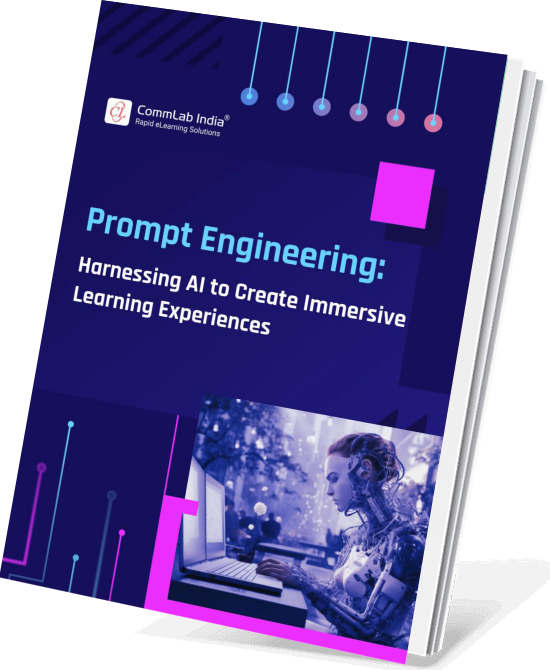The Power of Priming: How to Guide AI for Optimal Responses

As Artificial Intelligence (AI) becomes increasingly embedded in Learning and Development (L&D) strategies, professionals are learning the art of prompting AI for desired outcomes. But there’s a powerful technique that takes AI interactions to the next level: priming. Much like how you prepare a learner for a new topic by giving them relevant context, priming AI involves feeding it essential background information before asking for its output.
In this blog, we’ll dive into what priming is, how it enhances AI responses, and how L&D professionals can leverage this technique to generate more accurate and meaningful content.
→ Download Now: Prompt Engineering for L&D Professionals!
Table of Content
- Priming in Prompt Engineering
- Providing Background for Better AI Responses
- Examples of Priming in Corporate Learning
- Techniques for Setting the Right Context
Introduction to Priming in Prompt Engineering
At its core, priming is the practice of giving AI key context or background before issuing your main query or request. In prompt engineering, priming allows you to guide AI’s understanding of a topic or situation, leading to more focused and relevant responses.
Just like you wouldn’t expect a learner to grasp complex ideas without foundational knowledge, you can’t expect AI to give optimal responses without proper priming. If you provide a clear context or framework for the AI, it’s far more likely to generate an output that meets your specific needs.
For instance, asking the AI to “Create a leadership development plan” may generate a general response, but priming it with background—such as the company’s size, culture, or challenges—will result in a much more targeted and useful plan.
Steps for Prime AI for Content Creation
- Set the stage
- Specify key constraints
- Provide clear objectives
How to Provide Background for Better AI Responses
Priming can be as simple as feeding the AI relevant details, constraints, or instructions before your main prompt. The goal is to create a shared understanding between you and the AI about what the task entails and what kind of output you’re expecting.
Here’s how you can provide background for better responses:
1. Set the Stage
Start by giving the AI necessary context that will shape its response. You can provide background on the target audience, the topic’s scope, or even the tone you’d like the AI to use.
Example:
Instead of asking:
“Create a training module on communication,” prime the AI by saying:
“We are designing a communication training module for entry-level employees at a tech company. The module should focus on improving virtual communication skills, with an emphasis on video conferencing etiquette and email communication. Use an informal, friendly tone.”
This will help the AI customize content generation to match your specific needs.
2. Incorporate Key Constraints
When you include constraints or limitations in your prompt, you give AI boundaries within which to operate. This could include word count, target audience knowledge level, or format.
Example:
“Generate a 500-word beginner-friendly guide on data privacy regulations for small business owners. Focus on GDPR and California Consumer Privacy Act (CCPA). Include two real-world examples.”
Here, by specifying constraints, you ensure that the AI focuses on the right regulations, keeps it simple for the audience, and provides examples, making the response more practical.
3. Provide Clear Objectives
Another form of priming is to clearly define what you want the AI to achieve. This could include desired outcomes or learning objectives for the content you’re generating.
Example:
“I need a 300-word summary of the benefits of microlearning for corporate training programs. By the end, the learner should understand how microlearning increases retention and fits into modern work schedules.”
By including clear objectives, you help AI structure the response in a way that achieves your instructional goals.
Examples of Priming in Corporate Learning
Let’s look at some specific use cases of priming in L&D, where you can apply this technique to generate better content for your learners:
1. Creating Tailored Training Modules
Suppose you’re tasked with creating a series of training modules for a company-wide onboarding program. Rather than asking the AI to produce generic content, priming allows you to get results that match the company’s specific context.
Example of an unprimed prompt:
“Write a training module for new hires.”
Example of a primed prompt:
“We are developing an onboarding training module for new hires at a fast-growing tech startup. Focus on company culture, expectations for remote work, and tips for integrating into a fast-paced team. The module should be concise, engaging, and accessible for employees from various professional backgrounds.”
In this scenario, priming helps the AI generate content that reflects the specific corporate culture and operational context, making the training more relevant for new employees.
2. Developing Case Studies for Scenario-based Learning
Priming is especially useful when creating detailed case studies or scenarios for employee training. If you provide background on the type of organization or the challenge being addressed, AI can generate case studies that are much more tailored and practical.
Example of an unprimed prompt:
“Create a case study on team conflict.”
Example of a primed prompt:
“Create a case study for a corporate training program where a project manager has to mediate a conflict between two team members in a marketing department. The conflict arises from differing opinions on how to approach a new product launch campaign. Provide three possible outcomes and ask learners to choose the best resolution.”
By feeding the AI this background information, the response is much more specific and useful in real-world corporate training scenarios.
3. Generating Assessments and Quizzes
AI can be incredibly useful for generating assessments, but the quality of the questions depends on how well you prime the system. Providing background on the course content and the learning objectives allows AI to create more aligned and focused assessments.
Example of an unprimed prompt:
“Generate quiz questions on time management.”
Example of a primed prompt:
“Generate five multiple-choice questions on time management for a corporate training course aimed at mid-level managers. The course focuses on prioritization techniques, delegation, and work-life balance.”
This not only ensures the questions are relevant but also aligns the assessment with the course’s objectives, making it a better tool for evaluating learner progress.
Techniques for Setting the Right Context
To master the art of priming, here are some techniques to ensure you’re setting the right context for AI responses:
1. Be Explicit
Don’t assume that the AI will understand unstated context. Be as explicit as possible when describing what you need. Include details about the audience, the objective, and any specific constraints.
For example, rather than saying, “Write about leadership,” be specific:
“Write a 300-word overview of leadership styles for mid-level managers in the healthcare industry. Focus on transformational and situational leadership and use real-world examples.”

Prompt Engineering — Harnessing AI to Create Immersive Learning Experiences
Learn the Art of Crafting Effective Prompts and Get Desired Outcomes
- What is Prompt Engineering?
- Why is Prompt Engineering Important?
- How to Craft Effective Prompts?
- And More!
2. Use Sequential Prompts
If you’re asking for a large or complex output, break it down into smaller steps. Sequential prompts allow the AI to process one part of the request at a time, leading to more organized and structured responses.
For example:
“Step 1: Write a 200-word introduction to time management for new employees. Step 2: Explain three common time management pitfalls in the corporate world. Step 3: Conclude with strategies for improving time management skills.”
3. Test and Refine
Priming is an iterative process. You may not get the perfect response on the first try. Experiment with different amounts of context, rephrase your prompts, and add constraints to guide the AI. Over time, you’ll develop a feel for how much priming is needed to get the optimal response.
4. Use Comparative Prompts
Sometimes, providing AI with a comparison can help set clearer expectations. For example, if you want a response in a specific tone or style, you could ask the AI to mimic another source.
Example:
“Write a 400-word overview of cybersecurity best practices for employees, using the same approachable tone as a blog from Forbes.”
This technique ensures the AI understands the tone or style you're aiming for.
In the ever-evolving world of AI, priming is a powerful tool for L&D professionals who want to fine-tune the content they generate. By providing AI with the necessary background, constraints, and objectives, you can guide it to deliver more relevant, focused, and effective content for corporate training and beyond.
The art of priming not only improves the quality of AI-generated responses but also ensures that your content is aligned with your organization’s unique context and learner needs. As AI continues to shape the future of learning, mastering the technique of priming will be an essential skill for L&D professionals who want to stay ahead of the curve.


![5 Benefits of Artificial Intelligence in eLearning [Infographic] 5 Benefits of Artificial Intelligence in eLearning [Infographic]](https://blog.commlabindia.com/hs-fs/hubfs/Imported_Blog_Media/artificial-learning-elearning-infographic.jpg?width=900&height=3349&name=artificial-learning-elearning-infographic.jpg)



